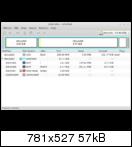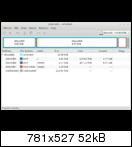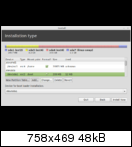Okay please step by step. I simplified the partitions a little bit so that I would have only one mdadm RAID /dev/md0 for root without a separate /home partition.
After manipulating with gparted fdisk -l gives me this now>
Code:
mint@mint ~ $ sudo fdisk -l
Disk /dev/sda: 16.0 GB, 16001269760 bytes
255 heads, 63 sectors/track, 1945 cylinders, total 31252480 sectors
Units = sectors of 1 * 512 = 512 bytes
Sector size (logical/physical): 512 bytes / 512 bytes
I/O size (minimum/optimal): 512 bytes / 512 bytes
Disk identifier: 0x00017dbe
Device Boot Start End Blocks Id System
/dev/sda1 * 2048 309247 153600 83 Linux
/dev/sda2 309248 22247423 10969088 83 Linux
/dev/sda3 22247424 31252479 4502528 5 Extended
/dev/sda5 22249472 31150079 4450304 82 Linux swap / Solaris
Disk /dev/sdb: 16.0 GB, 16001269760 bytes
255 heads, 63 sectors/track, 1945 cylinders, total 31252480 sectors
Units = sectors of 1 * 512 = 512 bytes
Sector size (logical/physical): 512 bytes / 512 bytes
I/O size (minimum/optimal): 512 bytes / 512 bytes
Disk identifier: 0x000d958a
Device Boot Start End Blocks Id System
/dev/sdb1 2048 21940223 10969088 83 Linux
/dev/sdb2 21940224 31252479 4656128 5 Extended
/dev/sdb5 21942272 30842879 4450304 82 Linux swap / Solaris
Disk /dev/sdc: 31.6 GB, 31641829376 bytes
255 heads, 63 sectors/track, 3846 cylinders, total 61800448 sectors
Units = sectors of 1 * 512 = 512 bytes
Sector size (logical/physical): 512 bytes / 512 bytes
I/O size (minimum/optimal): 512 bytes / 512 bytes
Disk identifier: 0xc3072e18
So my next step in this case would be:
Code:
mdadm --create /dev/md0 --chunk=4 --level=0 --raid-devices=2 /dev/sda2 /dev/sdb1
And right after I should be able to run the installation? I would choose manual installation and put md0 as root mounting point. I leave everything else alone except that i choose /dev/sda as 'device for boot loader' installation and that's it ?
..continued:
Code:
mdadm: /dev/sda2 appears to contain an ext2fs file system
size=10969088K mtime=Thu Jan 1 00:00:00 1970
mdadm: /dev/sdb1 appears to contain an ext2fs file system
size=10969088K mtime=Thu Jan 1 00:00:00 1970
Continue creating array? y
mdadm: Defaulting to version 1.2 metadata
mdadm: array /dev/md0 started.
Code:
sudo fdisk -l
Disk /dev/sda: 16.0 GB, 16001269760 bytes
255 heads, 63 sectors/track, 1945 cylinders, total 31252480 sectors
Units = sectors of 1 * 512 = 512 bytes
Sector size (logical/physical): 512 bytes / 512 bytes
I/O size (minimum/optimal): 512 bytes / 512 bytes
Disk identifier: 0x00017dbe
Device Boot Start End Blocks Id System
/dev/sda1 * 2048 309247 153600 83 Linux
/dev/sda2 309248 22247423 10969088 83 Linux
/dev/sda3 22247424 31252479 4502528 5 Extended
/dev/sda5 22249472 31150079 4450304 82 Linux swap / Solaris
Disk /dev/sdb: 16.0 GB, 16001269760 bytes
255 heads, 63 sectors/track, 1945 cylinders, total 31252480 sectors
Units = sectors of 1 * 512 = 512 bytes
Sector size (logical/physical): 512 bytes / 512 bytes
I/O size (minimum/optimal): 512 bytes / 512 bytes
Disk identifier: 0x000d958a
Device Boot Start End Blocks Id System
/dev/sdb1 2048 21940223 10969088 83 Linux
/dev/sdb2 21940224 31252479 4656128 5 Extended
/dev/sdb5 21942272 30842879 4450304 82 Linux swap / Solaris
Disk /dev/sdc: 31.6 GB, 31641829376 bytes
255 heads, 63 sectors/track, 3846 cylinders, total 61800448 sectors
Units = sectors of 1 * 512 = 512 bytes
Sector size (logical/physical): 512 bytes / 512 bytes
I/O size (minimum/optimal): 512 bytes / 512 bytes
Disk identifier: 0xc3072e18
Device Boot Start End Blocks Id System
/dev/sdc1 * 2048 61800447 30899200 c W95 FAT32 (LBA)
Disk /dev/md0: 22.5 GB, 22464675840 bytes
2 heads, 4 sectors/track, 5484540 cylinders, total 43876320 sectors
Units = sectors of 1 * 512 = 512 bytes
Sector size (logical/physical): 512 bytes / 512 bytes
I/O size (minimum/optimal): 4096 bytes / 8192 bytes
Disk identifier: 0x00000000
Disk /dev/md0 doesn't contain a valid partition table




 Adv Reply
Adv Reply









Bookmarks